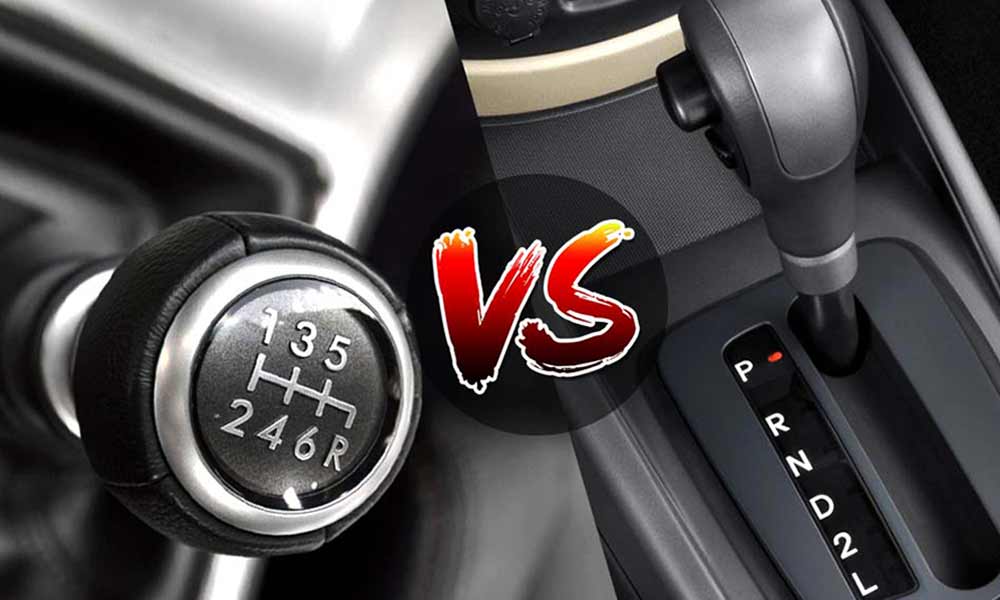
Arguing about whether automatic or manual cars are better is an unending debate, but which one can we advise you to buy?
What’s the difference between a manual and an automatic car?
The main difference between the two is that automatic cars do not have a clutch pedal, and they have a more straightforward gearbox. Vehicles with a manual transmission feature five or six ratios, plus reverse, providing you with complete control over the vehicle’s performance.
Vehicles with automatic transmissions usually have four modes: Drive-D, Park-P, Reverse-R, and Neutral-N.
The car chooses the appropriate gear based on the speed and road conditions. This means that all you have to consider is whether you’re moving forward, backward, or stopping.
There are different types of automatic transmissions, including Continuously Variable Transaxle (CVT) gearboxes, single automated clutches, and twin clutches.
Manual cars
When you drive, your car’s engine needs to shift gears to suit your speed in order to work efficiently. You shift into a higher gear as you drive faster. This is true for both manual and automatic transmission vehicles, but for manual cars, the driver has to change the gears manually by using a clutch and a stick shift.
It was once widely accepted that manual cars were less expensive and more fuel-efficient. Today, though, this isn’t always the case. Some modern vehicles are exclusively available with automatic transmissions, and there are various types of automatic vehicles that employ various technologies. Some are more fuel-efficient than a car with a manual transmission, while others aren’t.

Manual transmissions are now frequently associated with high-performance or premium vehicles. However, this is a myth. Manual cars are not superior to automatics in terms of performance. It all depends on the car.
Also, knowing how to drive a manual car doesn’t make you a better driver; some people just love driving with more mechanical involvement and some don’t. Essentially, it comes down to what makes you feel the most at ease. While learning to drive in a manual is the best option if you can because it provides you with more alternatives in the future, learning to drive in an automatic is not bad either. It all depends on what kind of car you want and how you’ll be driving.
So the main advantage of driving a manual car is that you have greater control over the vehicle. If you need to shift to a lower gear during an uphill climb to add more power, you can easily do it. If you need to change from the second gear to the fourth, you can also do it.
Another major advantage is that sometimes drivers just feel nice when shifting gears. It’s a learned skill that old drivers still want to utilize. In addition to that, there is the fact that drivers who can drive manuals can drive automatics, but the reverse is not true.
Automatic cars
Park (P), Reverse (R), Neutral (N), and Drive (D) are the four modes found in most automatic vehicles. There is no clutch because there is no need to change gears; there is just the brake and accelerator. That means you only have to consider whether you’re going forward, backward, or stopping; the car will take care of the rest.

This makes automatics a lot easier to drive. Stalling is also no longer an issue because there is no need to press the clutch or select the proper gear. This makes the transition between gears a lot smoother, providing a more comfortable and judder-free ride.
Automatic transmissions make driving in slow-moving or stop-and-go traffic much easier.
This makes them a better option if you’ll be driving in heavy traffic or in a similarly challenging situation. They are also the preferred choice if you want to make driving as simple as possible.
However, they can be more expensive to purchase and fix if something goes wrong, but because there’s less chance of accidentally grinding the gears, the transmission itself is less likely to fail.
Best of both worlds
We now have automatics with manual options, giving you the best of both worlds. Automatic Tiptronic or Steptronic vehicles can be driven as a manual, with a sequential gearchange, or as a responsive automatic. This means that you get the control of manually changing gears without the stress of using a clutch and a stick shift.
Conclusion
In the future, however, manual vehicles will probably be extinct. When we look at hybrid cars, we see that this new technology doesn’t function with manual cars since the car needs to control the speed range. Also, fully electric cars, on the other hand, rarely require a transmission.
Since Europe and Japan are banning the sale of new fuel vehicles by 2030, electrified vehicles, both hybrid and fully electric, will probably play a larger role in the future.
